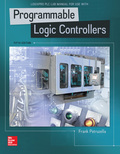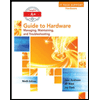
EBK LOGIXPRO PLC LAB MANUAL FOR PROGRAM
5th Edition
ISBN: 8220102803503
Author: Petruzella
Publisher: YUZU
expand_more
expand_more
format_list_bulleted
Expert Solution & Answer
Chapter 15.6, Problem 3P
Explanation of Solution
Changes made on given FBD
- To change the on-delay time of the given program, change the timer from 10 seconds to 1 minute, the user should change the value of the input reference connected to the “PRE” pin to “60000”.
- Reasons:
- In the FBD program, the value of time base for preset (PRE) is always 1 msec.
- From the given question, the value of PRE should be changed from 10 seconds to 1 minute...
Expert Solution & Answer
Want to see the full answer?
Check out a sample textbook solution
Students have asked these similar questions
Please do not use any AI tools to solve this question.
I need a fully manual, step-by-step solution with clear explanations, as if it were done by a human tutor.
No AI-generated responses, please.
Obtain the MUX design for the function F(X,Y,Z) = (0,3,4,7) using an off-the-shelf MUX with an active low strobe input (E).
I cannot program smart home automation rules from my device using a computer or phone, and I would like to know how to properly connect devices such as switches and sensors together ?
Cisco Packet Tracer
1. Smart Home Automation:o Connect a temperature sensor and a fan to a home gateway.o Configure the home gateway so that the fan is activated when the temperature exceedsa set threshold (e.g., 30°C).2. WiFi Network Configuration:o Set up a wireless LAN with a unique SSID.o Enable WPA2 encryption to secure the WiFi network.o Implement MAC address filtering to allow only specific clients to connect.3. WLC Configuration:o Deploy at least two wireless access points connected to a Wireless LAN Controller(WLC).o Configure the WLC to manage the APs, broadcast the configured SSID, and applyconsistent security settings across all APs.
Chapter 15 Solutions
EBK LOGIXPRO PLC LAB MANUAL FOR PROGRAM
Ch. 15.1 - Prob. 1RQCh. 15.1 - Prob. 2RQCh. 15.1 - Prob. 3RQCh. 15.1 - Prob. 4RQCh. 15.1 - Prob. 5RQCh. 15.1 - Prob. 6RQCh. 15.1 - Prob. 7RQCh. 15.1 - Prob. 8RQCh. 15.1 - Prob. 9RQCh. 15.1 - Prob. 10RQ
Ch. 15.1 - Prob. 11RQCh. 15.1 - Compare the accessibility of program scope and...Ch. 15.1 - Prob. 13RQCh. 15.1 - What is the difference between a produced tag and...Ch. 15.1 - Prob. 15RQCh. 15.1 - State the data type used for each of the...Ch. 15.1 - Describe the make-up of a predefined structure.Ch. 15.1 - Describe the make-up of a module-defined...Ch. 15.1 - Describe the make-up of a user-defined structure.Ch. 15.1 - Prob. 20RQCh. 15.1 - Prob. 21RQCh. 15.1 - Prob. 22RQCh. 15.1 - Prob. 23RQCh. 15.2 - Prob. 1RQCh. 15.2 - Prob. 2RQCh. 15.2 - Prob. 3RQCh. 15.2 - Prob. 4RQCh. 15.2 - Prob. 5RQCh. 15.2 - Prob. 6RQCh. 15.2 - Prob. 7RQCh. 15.2 - Prob. 8RQCh. 15.2 - Prob. 9RQCh. 15.2 - Prob. 10RQCh. 15.2 - Prob. 11RQCh. 15.2 - Extend control of the original ControlLogix...Ch. 15.2 - Prob. 3PCh. 15.3 - Prob. 1RQCh. 15.3 - Prob. 2RQCh. 15.3 - Prob. 3RQCh. 15.3 - Prob. 4RQCh. 15.3 - Prob. 5RQCh. 15.3 - Prob. 6RQCh. 15.3 - Prob. 7RQCh. 15.3 - Prob. 8RQCh. 15.3 - Prob. 9RQCh. 15.3 - Prob. 10RQCh. 15.3 - Prob. 11RQCh. 15.3 - Prob. 12RQCh. 15.3 - Modify the original CLX ten-second TON timer...Ch. 15.3 - Prob. 2PCh. 15.3 - Prob. 3PCh. 15.3 - Prob. 4PCh. 15.3 - Prob. 5PCh. 15.3 - Prob. 6PCh. 15.4 - Prob. 1RQCh. 15.4 - Prob. 2RQCh. 15.4 - Prob. 3RQCh. 15.4 - Prob. 4RQCh. 15.4 - Prob. 5RQCh. 15.4 - Prob. 6RQCh. 15.4 - Prob. 7RQCh. 15.4 - Prob. 1PCh. 15.4 - Prob. 2PCh. 15.5 - Prob. 1RQCh. 15.5 - Prob. 2RQCh. 15.5 - Prob. 3RQCh. 15.5 - Prob. 4RQCh. 15.5 - Prob. 5RQCh. 15.5 - Construct a ControlLogix ladder rung with compare...Ch. 15.5 - Prob. 2PCh. 15.5 - A single pole switch is used in place of the two...Ch. 15.6 - Prob. 1RQCh. 15.6 - Name the four basic elements of an FBD.Ch. 15.6 - Prob. 3RQCh. 15.6 - Prob. 4RQCh. 15.6 - Prob. 5RQCh. 15.6 - Prob. 6RQCh. 15.6 - Prob. 7RQCh. 15.6 - Prob. 8RQCh. 15.6 - Prob. 9RQCh. 15.6 - Prob. 10RQCh. 15.6 - Prob. 11RQCh. 15.6 - How is a function block feedback loop created?Ch. 15.6 - Prob. 13RQCh. 15.6 - Prob. 14RQCh. 15.6 - Prob. 1PCh. 15.6 - Prob. 2PCh. 15.6 - Prob. 3PCh. 15.6 - Prob. 4PCh. 15.6 - Prob. 5P
Knowledge Booster
Similar questions
- using r language for integration theta = integral 0 to infinity (x^4)*e^(-x^2)/2 dx (1) use the density function of standard normal distribution N(0,1) f(x) = 1/sqrt(2pi) * e^(-x^2)/2 -infinity <x<infinity as importance function and obtain an estimate theta 1 for theta set m=100 for the estimate whatt is the estimate theta 1? (2)use the density function of gamma (r=5 λ=1/2)distribution f(x)=λ^r/Γ(r) x^(r-1)e^(-λx) x>=0 as importance function and obtain an estimate theta 2 for theta set m=1000 fir the estimate what is the estimate theta2? (3) use simulation (repeat 1000 times) to estimate the variance of the estimates theta1 and theta 2 which one has smaller variance?arrow_forwardusing r language A continuous random variable X has density function f(x)=1/56(3x^2+4x^3+5x^4).0<=x<=2 (1) secify the density g of the random variable Y you find for the acceptance rejection method. (2) what is the value of c you choose to use for the acceptance rejection method (3) use the acceptance rejection method to generate a random sample of size 1000 from the distribution of X .graph the density histogram of the sample and compare it with the density function f(x)arrow_forwardusing r language a continuous random variable X has density function f(x)=1/4x^3e^-(pi/2)^4,x>=0 derive the probability inverse transformation F^(-1)x where F(x) is the cdf of the random variable Xarrow_forward
- using r language in an accelerated failure test, components are operated under extreme conditions so that a substantial number will fail in a rather short time. in such a test involving two types of microships 600 chips manufactured by an existing process were tested and 125 of them failed then 800 chips manufactured by a new process were tested and 130 of them failed what is the 90%confidence interval for the difference between the proportions of failure for chips manufactured by two processes? using r languagearrow_forwardI want a picture of the tools and the pictures used Cisco Packet Tracer Smart Home Automation:o Connect a temperature sensor and a fan to a home gateway.o Configure the home gateway so that the fan is activated when the temperature exceedsa set threshold (e.g., 30°C).2. WiFi Network Configuration:o Set up a wireless LAN with a unique SSID.o Enable WPA2 encryption to secure the WiFi network.o Implement MAC address filtering to allow only specific clients to connect.3. WLC Configuration:o Deploy at least two wireless access points connected to a Wireless LAN Controller(WLC).o Configure the WLC to manage the APs, broadcast the configured SSID, and applyconsistent security settings across all APs.arrow_forwardA. What will be printed executing the code above?B. What is the simplest way to set a variable of the class Full_Date to January 26 2020?C. Are there any empty constructors in this class Full_Date?a. If there is(are) in which code line(s)?b. If there is not, how would an empty constructor be? (create the code lines for it)D. Can the command std::cout << d1.m << std::endl; be included after line 28 withoutcausing an error?a. If it can, what will be printed?b. If it cannot, how could this command be fixed?arrow_forward
- Cisco Packet Tracer Smart Home Automation:o Connect a temperature sensor and a fan to a home gateway.o Configure the home gateway so that the fan is activated when the temperature exceedsa set threshold (e.g., 30°C).2. WiFi Network Configuration:o Set up a wireless LAN with a unique SSID.o Enable WPA2 encryption to secure the WiFi network.o Implement MAC address filtering to allow only specific clients to connect.3. WLC Configuration:o Deploy at least two wireless access points connected to a Wireless LAN Controller(WLC).o Configure the WLC to manage the APs, broadcast the configured SSID, and applyconsistent security settings across all APs.arrow_forwardTransform the TM below that accepts words over the alphabet Σ= {a, b} with an even number of a's and b's in order that the output tape head is positioned over the first letter of the input, if the word is accepted, and all letters a should be replaced by the letter x. For example, for the input aabbaa the tape and head at the end should be: [x]xbbxx z/z,R b/b,R F ① a/a,R b/b,R a/a, R a/a,R b/b.R K a/a,R L b/b,Rarrow_forwardGiven the C++ code below, create a TM that performs the same operation, i.e., given an input over the alphabet Σ= {a, b} it prints the number of letters b in binary. 1 #include 2 #include 3 4- int main() { std::cout > str; for (char c : str) { if (c == 'b') count++; 5 std::string str; 6 int count = 0; 7 char buffer [1000]; 8 9 10 11- 12 13 14 } 15 16- 17 18 19 } 20 21 22} std::string binary while (count > 0) { binary = std::to_string(count % 2) + binary; count /= 2; std::cout << binary << std::endl; return 0;arrow_forward
- Considering the CFG described below, answer the following questions. Σ = {a, b} • NT = {S} Productions: P1 S⇒aSa P2 P3 SbSb S⇒ a P4 S⇒ b A. List one sequence of productions that can accept the word abaaaba; B. Give three 5-letter words that can be accepted by this CFG; C. Create a Pushdown automaton capable of accepting the language accepted by this CFG.arrow_forwardGiven the FSA below, answer the following questions. b 1 3 a a b b с 2 A. Write a RegEx that is equivalent to this FSA as it is; B. Write a RegEx that is equivalent to this FSA removing the states and edges corresponding to the letter c. Note: To both items feel free to use any method you want, including analyzing which words are accepted by the FSA, to generate your RegEx.arrow_forward3) Finite State Automata Given the FSA below, answer the following questions. a b a b 0 1 2 b b 3 A. Give three 4-letter words that can be accepted by this FSA; B. Give three 4-letter words that cannot be accepted by this FSA; C. How could you describe the words accepted by this FSA? D. Is this FSA deterministic or non-deterministic?arrow_forward
arrow_back_ios
SEE MORE QUESTIONS
arrow_forward_ios
Recommended textbooks for you
- Programming Logic & Design ComprehensiveComputer ScienceISBN:9781337669405Author:FARRELLPublisher:Cengage
 A+ Guide to Hardware (Standalone Book) (MindTap C...Computer ScienceISBN:9781305266452Author:Jean AndrewsPublisher:Cengage Learning
A+ Guide to Hardware (Standalone Book) (MindTap C...Computer ScienceISBN:9781305266452Author:Jean AndrewsPublisher:Cengage Learning Enhanced Discovering Computers 2017 (Shelly Cashm...Computer ScienceISBN:9781305657458Author:Misty E. Vermaat, Susan L. Sebok, Steven M. Freund, Mark Frydenberg, Jennifer T. CampbellPublisher:Cengage Learning
Enhanced Discovering Computers 2017 (Shelly Cashm...Computer ScienceISBN:9781305657458Author:Misty E. Vermaat, Susan L. Sebok, Steven M. Freund, Mark Frydenberg, Jennifer T. CampbellPublisher:Cengage Learning  EBK JAVA PROGRAMMINGComputer ScienceISBN:9781305480537Author:FARRELLPublisher:CENGAGE LEARNING - CONSIGNMENT
EBK JAVA PROGRAMMINGComputer ScienceISBN:9781305480537Author:FARRELLPublisher:CENGAGE LEARNING - CONSIGNMENT A+ Guide To It Technical SupportComputer ScienceISBN:9780357108291Author:ANDREWS, Jean.Publisher:Cengage,
A+ Guide To It Technical SupportComputer ScienceISBN:9780357108291Author:ANDREWS, Jean.Publisher:Cengage, Systems ArchitectureComputer ScienceISBN:9781305080195Author:Stephen D. BurdPublisher:Cengage Learning
Systems ArchitectureComputer ScienceISBN:9781305080195Author:Stephen D. BurdPublisher:Cengage Learning

Programming Logic & Design Comprehensive
Computer Science
ISBN:9781337669405
Author:FARRELL
Publisher:Cengage

A+ Guide to Hardware (Standalone Book) (MindTap C...
Computer Science
ISBN:9781305266452
Author:Jean Andrews
Publisher:Cengage Learning

Enhanced Discovering Computers 2017 (Shelly Cashm...
Computer Science
ISBN:9781305657458
Author:Misty E. Vermaat, Susan L. Sebok, Steven M. Freund, Mark Frydenberg, Jennifer T. Campbell
Publisher:Cengage Learning

EBK JAVA PROGRAMMING
Computer Science
ISBN:9781305480537
Author:FARRELL
Publisher:CENGAGE LEARNING - CONSIGNMENT

A+ Guide To It Technical Support
Computer Science
ISBN:9780357108291
Author:ANDREWS, Jean.
Publisher:Cengage,

Systems Architecture
Computer Science
ISBN:9781305080195
Author:Stephen D. Burd
Publisher:Cengage Learning